 |

State of Alaska > DOLWD > Alaska
Economic Trends
2004 Alaska Economic Trends
Alaska Economic Trends are searchable from 1978 to the present using the Trends search page. The search can include any combination of the title or subtitle, date or date range, author, or full text.
|
| December 2004 |
Residency and the
Alaska Fisheries |
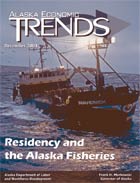 |
In many ways the term “Alaska fisheries”
is both vague and misleading. It is vague in the sense that these
fisheries include both small-scale ventures such as clam digging
and the industrial levels of investment and organization required
of modern factory trawlers. The former are often sources of supplemental
income, while the latter involve the financial complexities of corporate
owned fleets of high volume catcher-processors.
December 2004 Trends
|
| |
|
| November 2004 |
The Kenai Peninsula |
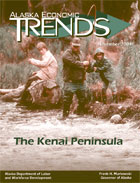 |
Few economies, if any in this state, have bragging
rights equal to those of the Kenai Peninsula Borough. Most communities
struggle to diversify their economies, but the Kenai Peninsula accomplished
this long ago. Fishing, the visitor industry, oil and gas, refining,
government, and its attractiveness as a haven for retirees, are
the fundamental economic drivers of the Kenai Peninsula economy.
November 2004 Trends |
| |
|
| October 2004 |
Occupational Forecast
|
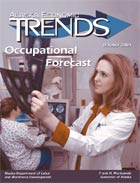 |
What will the occupational mix of Alaska’s economy
look like a decade from now? In which occupations will increases be
necessary to meet the demands of an evolving job market over this
period? These are important questions for the future of our state,
with ramifications for educators, training providers, and policy makers
on the one hand, and on the other, for the Alaska workers who will
ultimately fill these positions.
October
2004 Trends |
| |
|
| September 2004 |
Ten Year Industry
Forecast |
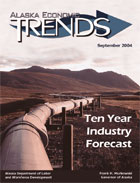 |
The number of jobs in Alaska is expected to grow
to 335,500 by 2012, an increase of more than 43,000. The forecast
can be characterized by continued growth in the near term, with
accelerated expansion near the end of the forecast period. The quickening
growth pace during the coming ten years is in part the result of
one of the major assumptions in this forecast—that construction
of an Alaska gas pipeline will start in 2012.
September 2004 Trends |
| |
|
| August 2004 |
The Trends 100 |
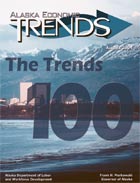 |
For the third year in a row in 2003 and probably
for many more to come, Providence Health System Alaska graced the
top of the list of Alaska’s largest employers. Just a decade
ago Providence had fewer than 2,000 employees. Its workforce of
3,556 is approximately 120 more than it was in 2002. Safeway/Carrs
was the runner-up for the third year in a row with 3,135 employees.
These two are the only employers that have broken the 3,000 barrier
and it probably will be years before any others reach this number.
August 2004 Trends |
| |
|
| July 2004 |
Migration |
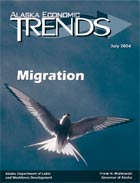 |
Of all the factors that influence the growth or
decline of a population, migration is the most important and the
most difficult to study and understand. Migration involves movement
of a person between two geopolitical locations over a period of
time. Different types of migration data yield different insights
into how people move in response to economic and other conditions.
July 2004 Trends |
| |
|
| June 2004 |
The Cost of Living
in Alaska |
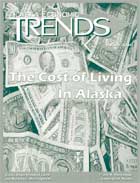 |
For years Alaska was correctly considered one of
the most expensive places to live in the nation. As recently as
1997, the American Chamber of Commerce Researchers ( ACCRA) cost
of living survey listed four Alaska cities in the eight most expensive
cities in the U.S. By 2003, only Juneau and Kodiak made the top
twenty and they were down to 16th and 17th, respectively.
June 2004 Trends |
| |
|
| May 2004 |
Employment Outlook
2004-2005 |
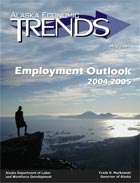 |
Alaska has produced job growth for sixteen consecutive
years, and is expected to add two more years to the streak in 2004
and 2005. (See Exhibits 1 and 2.) Growth rates of roughly two percent
from 2000 to 2002 slowed to 1.5 percent in 2003 and are expected
to remain near that level for the next two years.
May 2004 Trends |
| |
|
| April 2004 |
The Year 2003 in
Review |
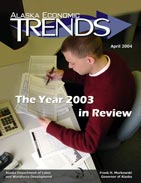 |
Alaska added about 4,500 new jobs in 2003, continuing
an impressive sixteen consecutive years of employment growth. Slightly
more than half of the new jobs were in health care and social assistance.
The state’s 1.5 percent growth rate in 2003 was down from
the levels of the last three years, but was still healthy compared
to most of the country, which continued to struggle to create jobs
following the 2001 recession.
April 2004 Trends |
| |
|
| March 2004 |
Southeast Alaska |
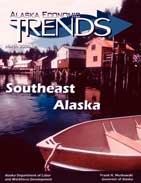 |
In the last decade, the communities of Southeast Alaska
have followed divergent economic paths. Juneau, the state’s
capital, has seen steady growth, while much of the rest of the region
has seen heavy job losses in the timber and fishing industries. Although
intuition might suggest that Juneau’s growth has been the result
of growing government, such intuition would be mistaken.
March
2004 Trends |
| |
|
| February 2004 |
Nonresidents Working
in Alaska |
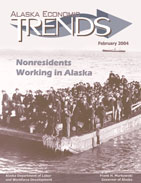 |
Throughout its history, Alaska has had a large number
of nonresident workers employed in the state. These workers were
required to meet the seasonal demands of resource based industries
or to meet the needs associated with major project development.
The fast paced growth of the early 1980s, particularly in the construction
industry, served as a magnet for a large number of nonresident workers,
but also served as an impetus for special Alaska resident hire preference
legislation.
February 2004 Trends |
| |
|
| January
2004 |
Leisure & Hospitality |
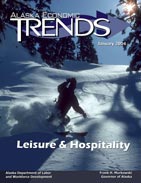 |
Most Alaskans are involved in the Leisure &
Hospitality sector of the economy in one of two ways: either they
are employed in it, or they patronize its hotels, health clubs,
bingo parlors, ski resorts, performing arts, or restaurants. In
2002, the Leisure & Hospitability sector generated nearly 30,000
jobs in Alaska, which amounted to ten percent of the wage and salary
workforce. (See Exhibit 1.) More than a billion dollars is spent
every year in Alaska on its varied offerings.
January 2004 Trends |
| |
|
Return to Top of Page
|















